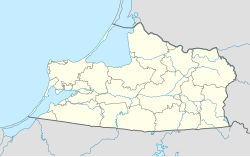| Druzhba Дружба | |
|---|---|
| Rural locality | |
 Gothic church Gothic church | |
| Location of Druzhba | |
   | |
| Coordinates: 54°29′33″N 21°11′32″E / 54.49250°N 21.19222°E / 54.49250; 21.19222 | |
| Country | Russia |
| Federal subject | Kaliningrad Oblast |
| Administrative district | Pravdinsky District |
| Founded | 1256 (Julian) |
| Elevation | 27 m (89 ft) |
| Population | |
| • Total | 440 |
| Time zone | UTC+2 (MSK–1 |
| Postal code(s) | 238405 |
| OKTMO ID | 27719000136 |
Druzhba (Russian: Дру́жба, German: Allenburg, Polish: Alembork, Lithuanian: Alna) is a rural locality (a village) in Pravdinsky District of Kaliningrad Oblast, Russia, located at the confluence of the Omet and Łyna rivers. Population: 440 (2010 Census); 515 (2002 Census); 1,750 (1900).
History

The town was captured by Polish King Władysław II Jagiełło in 1410. In 1440, the town was one of the founding members of the Prussian Confederation, which opposed Teutonic rule, and upon the request of which King Casimir IV Jagiellon incorporated the territory to the Kingdom of Poland in 1454. After the subsequent Thirteen Years' War (1454–1466), it became a part of Poland as a fief held by the Teutonic Knights.
From the 18th century, it formed part of the Kingdom of Prussia. During the Seven Years' War, it was captured by Russia in 1757 and 1758, and then occupied by Russia until 1762. From 1871 it was also part of Germany. The Provincial Sanatorium and Nursing Institution Allenberg was a psychiatric hospital in Allenberg from 1852 to 1940. In the late 19th century, the town had a population of 2,200, and eight annual fairs were held there. After World War II, the town was renamed to Druzhba.
Sights
The local Orthodox church is a medieval Brick Gothic building. There are also two locks of the Masurian Canal in the village.
Notable residents
- Julius Hallervorden (1882–1965), German physician and neuroscientist
References
- ^ Russian Federal State Statistics Service (2011). Всероссийская перепись населения 2010 года. Том 1 [2010 All-Russian Population Census, vol. 1]. Всероссийская перепись населения 2010 года (in Russian). Federal State Statistics Service.
- "Об исчислении времени". Официальный интернет-портал правовой информации (in Russian). 3 June 2011. Retrieved 19 January 2019.
- Почта России. Информационно-вычислительный центр ОАСУ РПО. (Russian Post). Поиск объектов почтовой связи (Postal Objects Search) (in Russian)
- Federal State Statistics Service (21 May 2004). Численность населения России, субъектов Российской Федерации в составе федеральных округов, районов, городских поселений, сельских населённых пунктов – районных центров и сельских населённых пунктов с населением 3 тысячи и более человек [Population of Russia, Its Federal Districts, Federal Subjects, Districts, Urban Localities, Rural Localities—Administrative Centers, and Rural Localities with Population of Over 3,000] (XLS). Всероссийская перепись населения 2002 года (in Russian).
- Meyers Großes Konversations-Lexikon (in German). Vol. 1. Leipzig. 1905. p. 345.
{{cite book}}: CS1 maint: location missing publisher (link) - ^ Słownik geograficzny Królestwa Polskiego i innych krajów słowiańskich, Tom I (in Polish). Warszawa. 1880. p. 26.
{{cite book}}: CS1 maint: location missing publisher (link) - Górski, Karol (1949). Związek Pruski i poddanie się Prus Polsce: zbiór tekstów źródłowych (in Polish). Poznań: Instytut Zachodni. p. 11.
- Górski, p. 54
- Górski, pp. 96–97, 214–215
- Ciesielski, Tomasz (2010). "Prusy Wschodnie w trakcie polskiej wojny sukcesyjnej i wojny siedmioletniej". In Gieszczyński, Witold; Kasparek, Norbert (eds.). Wielkie wojny w Prusach. Działania militarne między dolną Wisłą a Niemnem na przestrzeni wieków (in Polish). Dąbrówno. p. 145. ISBN 978-83-62552-00-9.
{{cite book}}: CS1 maint: location missing publisher (link)